 Copyright © Michael Richmond.
This work is licensed under a Creative Commons License.
Copyright © Michael Richmond.
This work is licensed under a Creative Commons License.
Estimating Distances to Far-away Galaxies
There are many different methods -- none of them very good --
which we can use to estimate the distance to far-away
galaxies;
or, more accurately,
estimate the relative distances of a far-away galaxy and the LMC.
All of our measurements of distant galaxies depend
upon the distance to the LMC, which is used as a stepping-stone.
So, if our distance to the LMC is uncertain by 10%, then
every single distance to another galaxy will be uncertain by at least 10%.
Remember that, whatever we use to measure these vast distances,
it must be very luminous.
Otherwise, we won't be able to see it in very distant
galaxies, halfway across the universe.
These methods fall into several different categories,
but most of them make some assumptions about global properties
of stars or galaxies (which are probably not true,
on a case-by-case basis).
Standard Candle methods
Astronomers would like dearly to discover that there is
some class of objects which all have exactly the
same luminosity.
We call such an ideal, mythical object a standard candle.
If we knew
- the luminosity of such an object
- the apparent brightness of such an object
then we could use the inverse square law to calculate its
distance. Simple!
Unfortunately, we have yet to discover any truly standard
"standard candle".
Here are some of the candidates scientists have
put forth over the years.
- Globular clusters: remember that a globular cluster
is a clump of thousands of stars, all packed together
into a small space.
 When we look at the globular clusters in our Milky Way,
we find that they span a large range in luminosity:
some are intrinsically very bright (because they have
lots of stars), and some are intrinsically very faint
(because they have few stars).
We can make a histogram of the luminosity function:
When we look at the globular clusters in our Milky Way,
we find that they span a large range in luminosity:
some are intrinsically very bright (because they have
lots of stars), and some are intrinsically very faint
(because they have few stars).
We can make a histogram of the luminosity function:
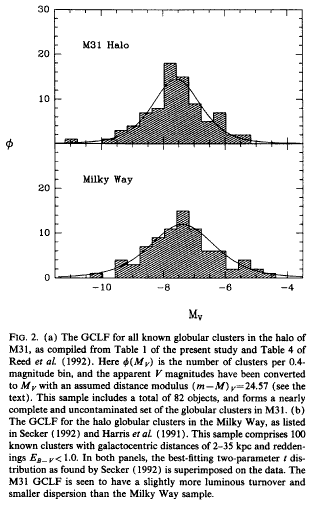
There are a few very bright clusters, a lot of "average"
clusters, and a few very faint ones.
Now, if we look at other galaxies, we can see globular clusters
around them, too:
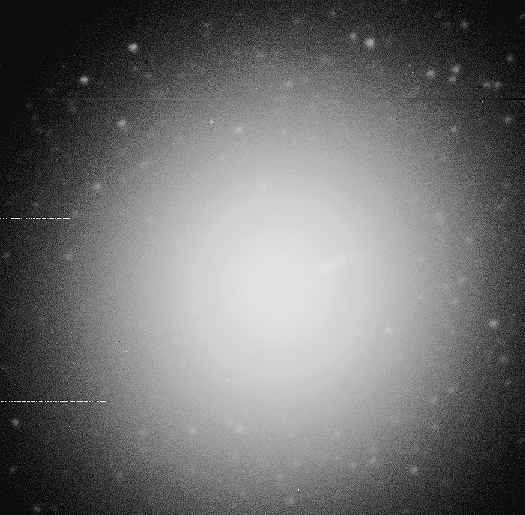
We can make histograms showing the brightness of their
globular clusters, too. For very nearby galaxies,
like Andromeda, this works pretty well. The amount
by which we need to shift the other galaxy's globular cluster
histogram in brightness to make it match our Milky Way's
tells us how far away it is (relative to the Milky Way).
But for really distant galaxies, we can only see the
very bright globular clusters:
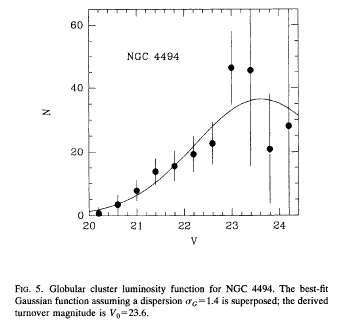
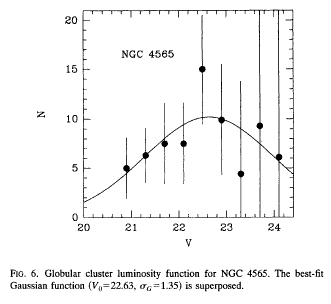
Trying to match these histograms against another galaxy's
histogram is really hard: if we can see the "turnover"
point (the "average" cluster), how can we match up
the peaks to find the shift?
Overall, this method only works for relatively nearby
galaxies: we can use it out at least as far as
the Virgo Cluster (about 20 Mpc).
I'm not sure that we can apply it out to the next big landmark,
the Coma Cluster (at about 100 Mpc).
- Type Ia Supernovae :
Supernovae are stars which explode, messily. They become
very, very luminous for a few short weeks, brighter than entire
galaxies, bright enough
that we can see them in very distant galaxies.
It would be great if all supernovae had exactly the same
peak luminosity, because they would make terrific standard
candles.
There are several mechanisms which can cause stars to explode.
Type Ia supernovae occur when, in a binary star system,
a main-sequence star dumps material onto a white dwarf companion:
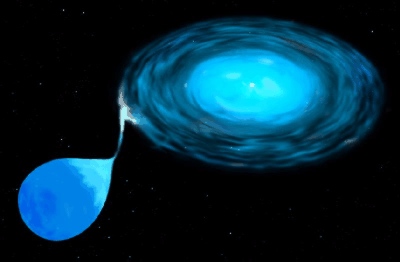
If the white dwarf accumulates enough material to push its
mass greater than about 1.4 solar masses, it explodes!
It brightens over a period of about two weeks, by a factor
of a million, and then fades slowly over several months:
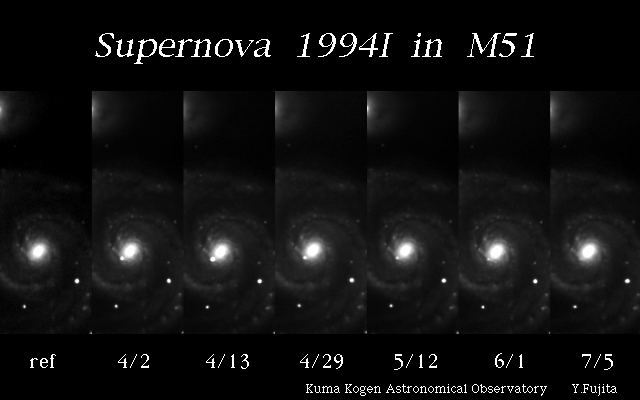


Since we think that all Type Ia supernovae occur when
this limit of 1.4 solar masses is reached, we think
that they all ought to have roughly similar peak luminosities.
Do they? Look at this graph of peak luminosity (on the vertical
axis) versus rate of decline after maximum (on horizontal axis,
with slow decliners at left and quick decliners at right):
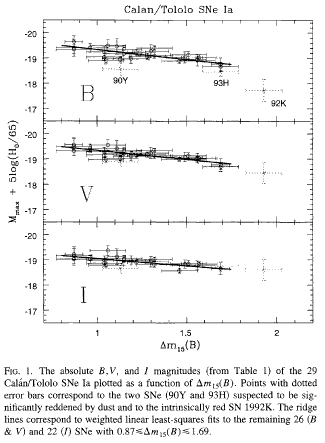
Clearly, some Type Ia supernovae are brighter than others,
so they aren't standard candles. But it also appears that
the difference in peak brightness is correlated with the
rate at which they fade: slow faders are bright,
quick faders are faint. There's hope that we can correct
for the difference in peak luminosity by using the
rate of fading after maximum ....
Type Ia supernovae are probably the closest thing to a
standard-izable candle that astronomers have
at the moment, and they can be seen at VERY large distances.
Recent observations of very distant Type Ia supernovae
have hinted that funny things are going on in the very
distant universe ....
- Brightest Cluster Galaxy (BCG) :
One of the oldest methods is also the simplest:
it assumes that the brightest elliptical galaxy in a
big, rich cluster always has exactly the same
luminosity. Why? Good question. In my opinion,
this is an assumption of desperation:
when we look at VERY distant clusters, we can see
only the brightest galaxies, and measure few of them
with precision. Brightest cluster galaxies
are the only game in town...
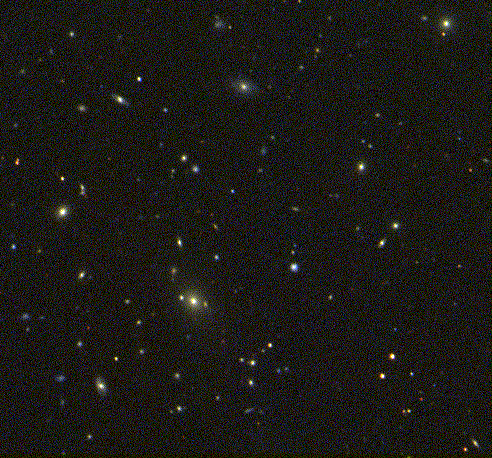
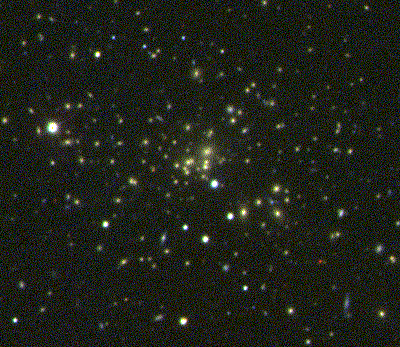
To be fair, there are indications that in many clusters,
the very brightest members really are quite similar.
For example, if all such galaxies really do have the same
luminosity, then they should fall in a straight line in
this diagram:
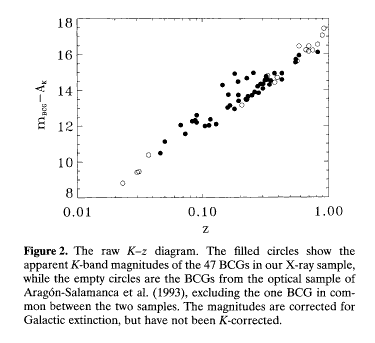
It appears that these galaxies are most similar if one
looks in the near-infrared, possibly because the obscuring
effects of any dust are minimized.
Overall, the BCG method is relatively imprecise (good to
only about 10 or 15 percent, at best, with careful selection),
but it can be used to very great distances.
Galaxies are built on the same plan
Ordinary galaxies are certainly not all the same:
there are big ones, small ones, spirals, ellipticals,
bright and faint galaxies.
So, it's obvious that they aren't standard candles.
But perhaps there are some common features -- blueprints, one
might say -- which underlie the structure of galaxies.
If we understand these blueprints, we might be able to
predict the luminosity of a galaxy from some other,
more easily measured property.
- Surface Brightness Fluctuations (SBF):
Galaxies are made up of stars -- lots and lots of stars.
In nearby galaxies, we can make out individual stars:
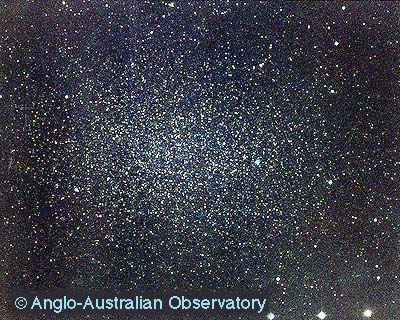
But in distant galaxies, the stars all blur together to form
what looks like a smooth bright area.

But if one looks very closely, one can see some "lumpiness"
in pictures of distant galaxies.
It's similar to the way that a smooth, nearly continuous
reproduction of a photograph breaks up into "lumps" if one
zooms in far enough:
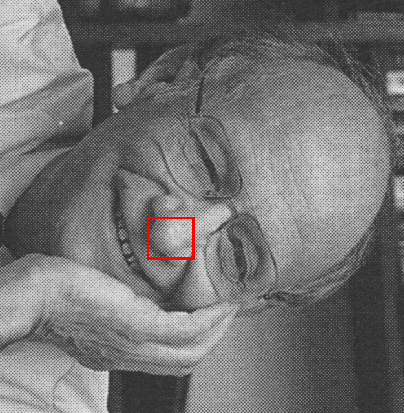


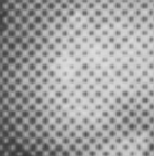
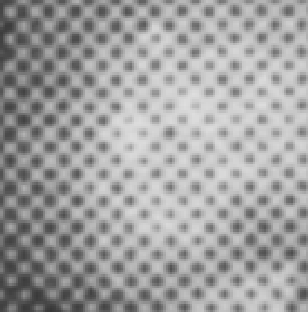
The amount of lumpiness gives us a clue to the galaxy's
distance:
- nearby galaxies are so lumpy we can distinguish
individual stars
- galaxies at intermediate distance are lumpy
- galaxies very far away are smooth
By measuring the size of the surface brightness fluctuations,
we can estimate the distance to a galaxy.
This method does assume that the stellar populations in all
galaxies (or maybe all elliptical galaxies) is very similar,
and that most of the "lumpiness" is due to old stars near the
peak of the red giant branch, and that the luminosity of those
stars in the red giant branch is the same in different galaxies.
That's a bunch of assumptions ... but it appears, empirically,
that they are often satisfied.
The SBF method can be used out to about 60 Mpc from the ground
(about twice as far as the Virgo cluster), and out to about
120 Mpc from space (about as far as the Coma cluster).
- Luminosity vs. Rotation:
Suppose that there are two galaxies, with identical shapes, sizes
and structures, but one (galaxy A) contains twice as many stars
as the other (galaxy B). Then we might expect:
- galaxy A should be twice as bright as galaxy B
- stars in galaxy A should feel stronger gravitational
forces than those in galaxy B, and so should
be moving around the center of the galaxy faster
It turns out that the factor by which stars move faster in
galaxy A is not simply "2"; instead, one can show with
some basic calculations that it's closer to a factor of
about sqrt(2), or 1.4.
But, whatever the factor is
(and, in real life, it's complicated by the range of sizes
of spiral galaxies), it's clear that more stars
should lead to faster motions.
A pair of astronomers named Tully and Fisher made a bunch
of observations to check this idea: they
measured
- the luminosity of a set of spiral galaxies
- the orbital velocities of stars in these galaxies,
based on the Doppler shift of lines in their spectra
When the compared the luminosities to the orbital velocities,
they found exactly the sort of relationship which the theory
predicts:
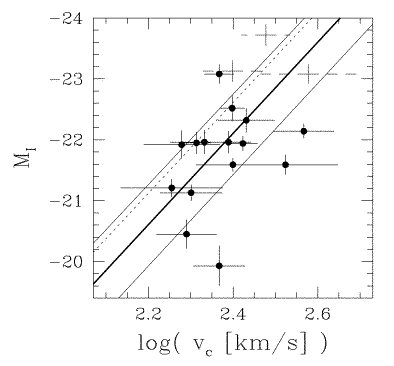
Now, the relationship isn't a very tight one: there's a lot
of scatter.
That means that the Tully-Fisher method is imprecise:
it yields a distance to a single galaxy with an uncertainty
of about 20 percent.
On the other hand, spiral galaxies are common, so one might
hope to average the distances to many spirals in a single
cluster and find a precise distance to the cluster.
Basic Physical principles
The two basic ideas underlying the methods described so far are:
- all objects of some class are identical in luminosity
- all galaxies are built to a similar plan
Both of these ideas are just that: ideas about the similarity of
whole classes of objects.
It surely would
be nice if these objects really were as similar as we hope ...
but there's no guarantee that they are.
Another approach is to study a single object,
not a group,
and apply basic physical principles to figure out
its particular properties: size, mass, luminosity.
This idea is attractive because it makes no assumptions
about a whole group of objects.
There are two techniques for measuring distances
which follow this approach.
- Type II Supernovae:
When a very massive star (more than 8 or 10 solar masses)
reaches the end of its life, it contains a very large,
extended outer envelope of hydrogen, surrounding a
dense, compact, core of heavier elements.
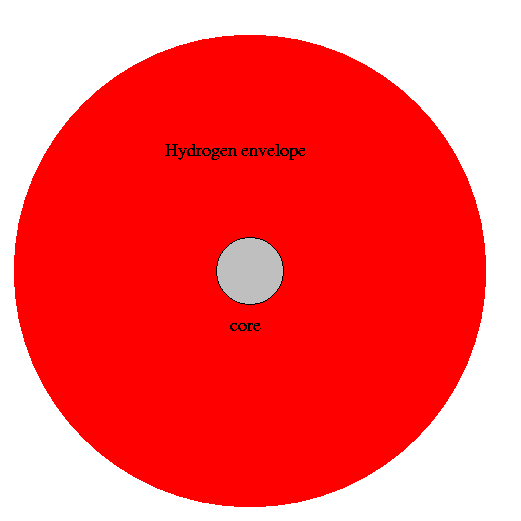
When the star runs out of fuel at its core, the core collapses
on itself, then rebounds, sending a shock wave outwards.
The shock wave
- heats the outer envelope of the star to over 100,000 Kelvin
- pushes out outwards at 5,000 to 10,000 km/sec
The outer envelope shoots outwards, making the star appear to
grow larger in a linear way: twice as big after two days,
three times as big after three days, etc.
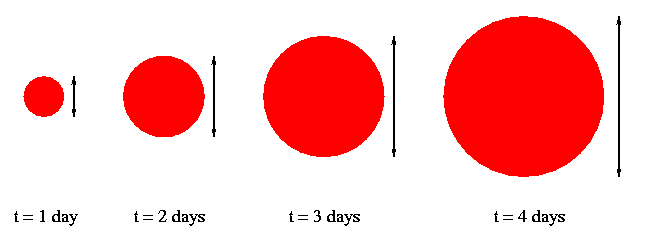
After just a few days, the temperature of the outer envelope
cools down from 100,000 Kelvin to about 4,000 Kelvin,
and then stays there for a few weeks.
Why? Because as the outermost layers of gas cool past
about 4,000 Kelvin, the hydrogen atoms go from an ionized
to a neutral state -- and turn transparent.
That allows us to see further into the layers of gas, to
material which is a bit hotter, still about 4,000 Kelvin.
Then those layers cool off a bit and turn transparent,
so we see still deeper layers at 4,000 Kelvin, and so on.
The result of all this is that the star
Now, if we know both the size and temperature
of an object, we can calculate its luminosity from
basic physical principles:
luminosity = (surface area) * (power per square meter)
2 4
= (4 pi radius ) * (sigma * T )
where sigma is the Stefan-Boltzmann constant.
So, by measuring the Doppler shift of lines in an expanding
Type II supernova, and knowing something about its atmosphere,
we can calculate its intrinsic luminosity. Comparing this
to its apparent brightness, we can figure out its distance
via the inverse square law.
How well does all this work?
The theoretical uncertainty ranges from only 15 percent
when we have many high-quality measurements of a supernova,
to more than 40 percent if we have little data.
Type II supernovae can be seen at great distances,
but they fade away after just a few weeks, so it's
difficult to get time on a big telescope quickly enough
to follow the really distant ones.
- Gravitational Lenses:
As described in an
earlier lecture,
if we can detect a time delay in the light coming
from different images formed by a gravitational lens,
we can apply some basic geometry to measure the distance
to the lens and the source.
We need to know
- the time delay -- which means the background source
must vary sharply, by large amounts, and do so while
we are watching
- the angular separation of the images of the background source
- the relative distances of lens and background source
(we can use the redshift for this)
- the mass of the lens, and its distribution
(a point mass? a big, uniform sphere? a sphere with
density decreasing outwards? an ellipsoid?)
It's that last item -- the mass of the lens, and its distribution
-- which is the real tough one.
How do we know the mass of the lensing galaxy?
Well, we need to assume that its properties are similar
to those of other, nearby galaxies, which we can study in
detail.
So, this method really does depend, indirectly, on other
methods for measuring distances to nearby galaxies.
How well does it work?
There are very few gravitational lenses for which we know all
the data needed to calculate distances.
Steven T. Myers writes in
"Scaling the universe: Gravitational lenses and the
Hubble constant"
that, as of early 1999, there were only about 4 systems
available for use.
name uncertainty in distance
----------------------------------------------------
Q0957+561 20% (according to one group)
100% (according to another group)
B0218+357 20% mass model uncertain
PG1115+080 25% mass model uncertain
B1608+656 25%
Using gravitational lenses to measure distance is dangerous,
because the results depend very strongly on the exact
model of the mass distribution in the lensing galaxy.
On the other hand, since we can see lensed quasars
from extremely large distances -- they are probably the
most distant objects we CAN see -- this method holds
a great attraction for cosmologists.
Summary
method works out to accuracy comments
=======================================================================
Globular cluster 50 Mpc? 25% ? not entirely consistent
luminosity function with other methods
Type Ia supernovae > 3000 Mpc 8-10% must correct for the
decline rate effect
Brightest Cluster > 3000 Mpc 20-30% must select carefully
Galaxy
Surface Brightness 60 Mpc 5-8% (from ground)
Fluctuations 120 Mpc (from space)
Rotation vs. 1000 Mpc 20% relatively easy to do
Luminosity
Type II supernovae 200 Mpc 15-40% requires spectra of high
quality
gravitational lenses > 5000 Mpc > 25% ? works at huge distances,
but models of lens masses
very uncertain
For more information, see
 Copyright © Michael Richmond.
This work is licensed under a Creative Commons License.
Copyright © Michael Richmond.
This work is licensed under a Creative Commons License.













 Copyright © Michael Richmond.
This work is licensed under a Creative Commons License.
Copyright © Michael Richmond.
This work is licensed under a Creative Commons License.








